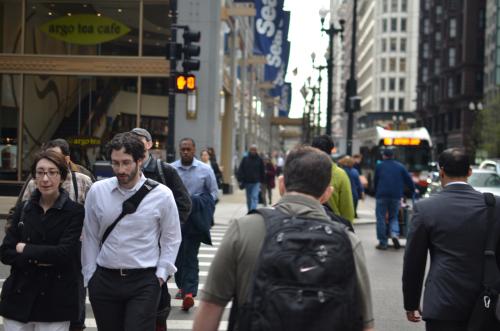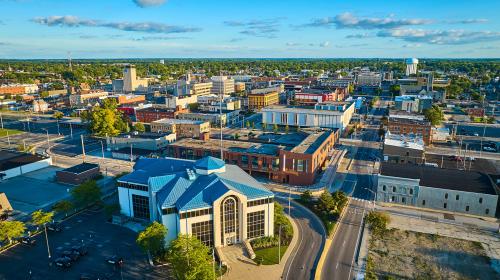Like Punxsutawney Phil, President Trump emerged—not from a hole in the ground, but on Twitter—on Friday, February 2 to forecast many more months of #MAGA based on that morning’s jobs report:
With 3.5 million Americans receiving bonuses or other benefits from their employers as a result of TAX CUTS, 2018 is off to great start!
✅Unemployment rate at 4.1%.
✅Average earnings up 2.9% in the last year.
✅200,000 new American jobs.
✅#MAGA?? https://t.co/upqSvBhRqJ— Donald J. Trump (@realDonaldTrump) February 2, 2018
That tweet marked Trump’s monthly celebration of the headline economic numbers that the U.S. Department of Labor reports each first Friday, including the unemployment rate, payroll employment, and average hourly earnings.
But the picture of the U.S. economy presented in Trump’s tweet is incomplete in at least three ways. First, monthly numbers don’t capture the longer periods over which most people judge their economic well-being (to be fair to Trump, the earnings figure is an annual one). Second, job market conditions are not the only barometers of that well-being. And third, the United States is a big country in which not every place experiences the same economic ebbs and flows.
These realities motivate the Brookings Metro Monitor, which reports on broader measures of economic success across the nation’s 100 largest metropolitan areas. It assesses each metro economy on indicators of economic growth (the size of the economic pie), prosperity (the quality of economic growth), and inclusion (the distribution of that growth).
The latest edition published last week paints a more sobering picture of progress, a picture that differs across three key periods the Monitor examines. How might President Trump—let’s say, in his more analytical moments—tweet about the results metro areas achieved over the last 10 years, five years, and one year?

2006-16: TEXAS killing it! But way too few metros truly bounced back from Great Recession. Need to boost entrepreneurship and continue helping workers back into labor market!
In each of the three categories noted (growth, prosperity, inclusion), the Metro Monitor tracks changes in three indicators for each metro area, for a total of nine indicators. Over the 10-year period ending in 2016, only six of the 100 largest metro areas posted positive progress in each of those nine indicators. Put another way, more than nine in 10 metro areas still had not completely recovered to their levels of pre-recession economic well-being by 2016.
Of the six metro areas that achieved truly inclusive economic growth and prosperity across the decade, four were in Texas—Austin, Dallas, Houston, and San Antonio. These places were only lightly hit by the housing downturn, and were buoyed by factors like rising domestic energy production and tech employment (particularly in Austin) throughout much of the decade.
A significant decline in entrepreneurialism, as measured by the number of jobs at firms less than five years old, held many metro areas back. Only 11 metro areas of 96 total (full data for Massachusetts metro areas aren’t available in this period) recovered to their pre-recession number of jobs at young firms by 2016. Nearly half of all places also had a lower share of their prime-age workers in jobs by 2016 than a decade before.

2011-16: Lots of metros making headway in the recovery, big and small! Texas still #winning, and now coasts are in the mix (plus DETROIT!)…. but more than 1/4 should truly succeed. Slow productivity growth a huge issue!
Beginning from a time of pretty widespread economic despair in 2011, more metro areas posted consistent gains on the Metro Monitor in the subsequent five years. Overall, 23 of the largest 100 metros achieved inclusive growth and prosperity from 2011 to 2016, including five of those that did so from 2006 to 2016. Among the other 18 were a number of large, coastal metro areas experiencing renewed growth in jobs and incomes, particularly in high-tech sectors (e.g., Boston, Los Angeles, Philadelphia, Bay Area, Seattle). But the Midwest/Rust Belt counted a number of strong performers, too, including Cincinnati, Detroit, Kansas City, Minneapolis-St. Paul, and Pittsburgh.
Of course, that means a little more than three-quarters of metro areas failed in at least one dimension to get back to even where they were in 2011. Here, productivity was the main culprit. Only 44 metro economies had a higher level of productivity in 2016 than in 2011. This reflects that many places of late have added large numbers of jobs in lower-productivity, lower-paying sectors of the economy (e.g., hospitality, construction). In many cases, that dynamic has helped bring more people back into the labor market, boosted median incomes, and reduced poverty. Yet the metro productivity slump, a dynamic shared with the wider U.S. economy, poses longer-term challenges for sustaining competitiveness and promoting upward mobility in these places.
2015-16: Don’t want to get too hung up on one year, but only 11 success stories? Continued momentum in a few places, but too much slippage! Productivity still a drag and need more progress against poverty.
Annual changes are less volatile than monthly ones, but they are more an indication of an economy’s trajectory than a definitive account of overall well-being. Nevertheless, only 11 of the largest 100 metros registered consistent progress across growth, prosperity, and inclusion from 2015 to 2016, which raises some concerns. Despite robust growth in GDP, jobs, and standards of living, even fewer metros achieved productivity growth across one year (36) than across five (44). Slow productivity growth in the medium-term may also relate to metro areas’ inconsistent progress against poverty in 2016, as perhaps too few metros are generating better-paying jobs that boost lower-wage workers into the middle class.
Five of the metro areas that achieved inclusive growth and prosperity from 2011 to 2016 demonstrated sustained momentum in the last year of that period: Cincinnati, Detroit, Minneapolis-St. Paul, San Francisco, and Spokane. That three of those are in the Midwest, and were joined by Des Moines and Madison among the 11, suggests that the wider region is achieving more than a short-term bounce-back from a rough downturn. Texas metro areas, on the other hand, dropped off the list, reflecting a sharp decline in energy prices that buffeted those economies (especially Houston’s) in 2015-16. (Bakersfield, an oil economy in California’s Central Valley, achieved progress on none of the nine indicators.)
***
Admittedly, this broader way of assessing economic success isn’t quite as Twitter-worthy as the monthly jobs report. But let’s face it, 280 characters aren’t really sufficient to guide the tough work local leaders do to steward America’s regional economies. In coming weeks, my Brookings colleagues and I will delve deeper into the Metro Monitor data to help regional leaders better understand what the results mean for creating viable pathways toward bottom-up, inclusive economic growth, and prosperity.







Commentary
Which metros are achieving true economic success?
February 26, 2018